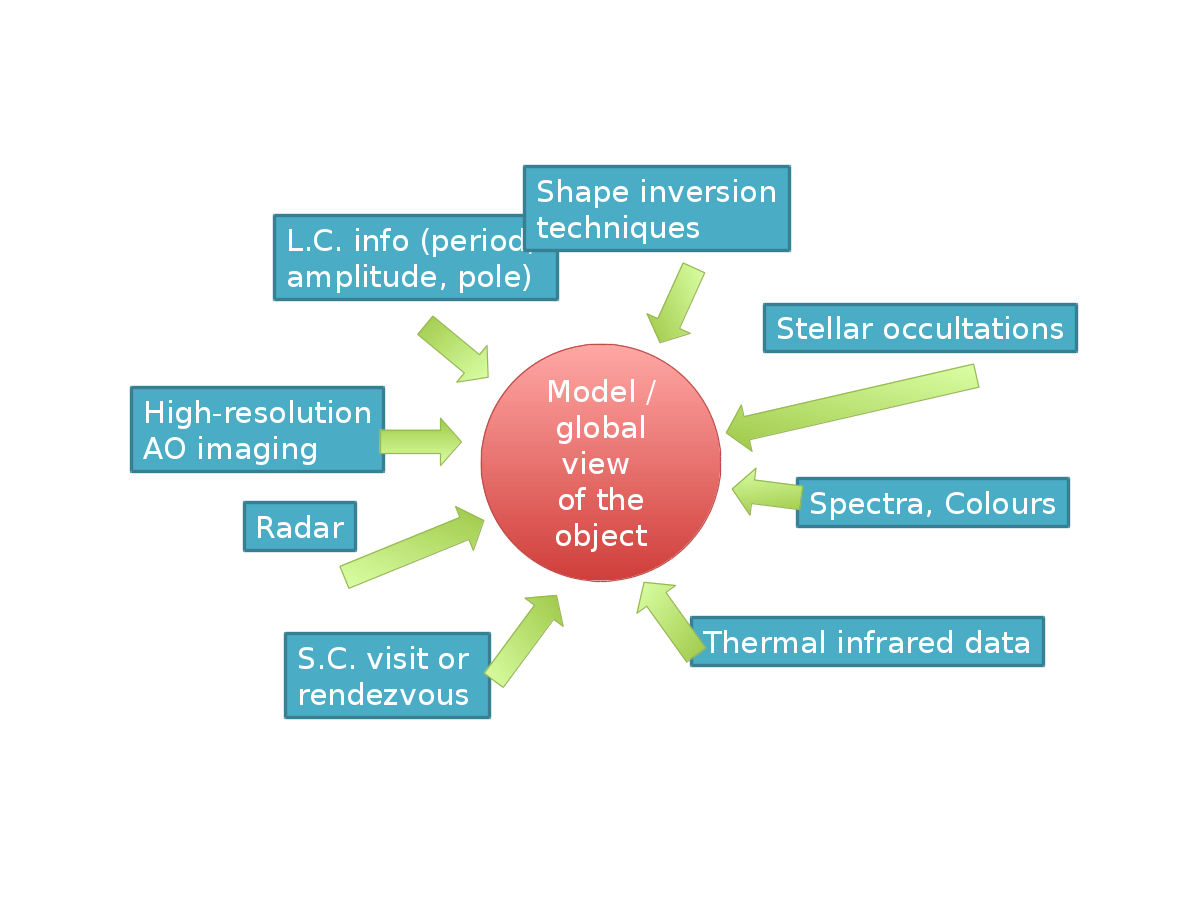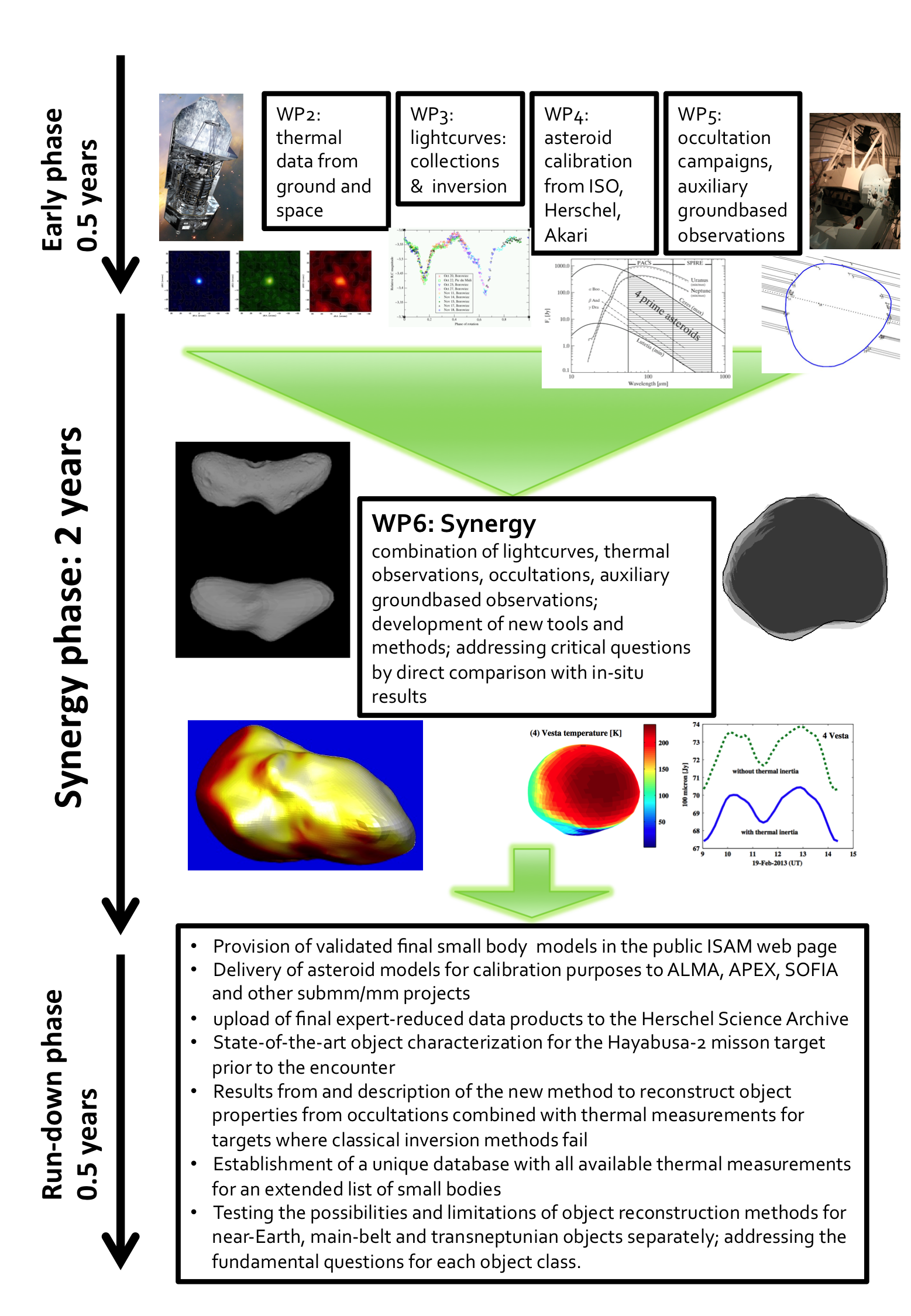Project
Abstract
The SBNAF project was an EU H2020-funded project during the years 2016 to 2019. Its scientific output, the various tools, services, products and synergy studies will influence the small-body research for many years to come.
We conducted a benchmark study that addressed critical points in reconstructing physical and thermal properties of near- Earth, main-belt, and trans-Neptunian objects. The combination of the visual and thermal data from the ground and from astrophysics missions (like Herschel, Spitzer and Akari) was key to improving the scientific understanding of these objects. The development of new tools was crucial for the interpretation of much larger data sets from WISE, Gaia, JWST, or NEOShield-2, but also for the operations and scientific exploitation of the Hayabusa-2 mission. Our approach was to combine different methods and techniques to get full information on selected bodies: lightcurve inversion, stellar occultations, thermo-physical modeling, radiometric methods, radar ranging and adaptive optics imaging. The applications to objects with ground-truth information from interplanetary missions Hayabusa, NEAR-Shoemaker, Rosetta, and DAWN allowed us to advance the techniques beyond the current state-of-the-art and to assess the limitations of each method. The SBNAF project derived sizes, spin and shape, thermal inertia, surface roughness, and in some cases even internal structure and composition, out to the most distant objects in the Solar System. Another important aim was to build accurate thermophysical asteroid models to establish new primary and secondary celestial calibrators for ALMA, SOFIA, APEX, and IRAM, as well as to provide a link to the high-quality calibration standards of Herschel and Planck. The target list comprised recent interplanetary mission targets, two samples of main-belt objects, representatives of the Trojan and Centaur populations, and all known dwarf planets (and candidates) beyond Neptune. Our team combined world-leading expertise in different scientific areas in a new European partnership with a high synergy potential in the field of small body and dwarf planet characterization, related to astrophysics, Earth, and planetary science.
- First periodic report (May 2017, covering first year):
Publishable summary (Part A) (pdf) &
Technical Report (Part B) (pdf) - Mid-term report (deliverable D1.3 in Nov 2017):
D1.3 Mid-term report (pdf) - Progress report, merged with Mid-term report D1.3 (May 2018, covering second year):
Publishable summary (Part A) & Technical report (Part B) (pdf) - Final report (May 2019, covering year 2 & 3):
Publishable summary (Part A) (pdf) &
Technical Report (Part B) (pdf)

Main Project Objectives
- Develop new tools and optimized procedures for the determination of size, shape, spin and thermal properties for NEAs, MBAs, and TNOs, from combined visual and infrared observations, both from space and from the ground.
- Provide expert-reduced maps and fluxes of Herschel measurements in the infrared for feedback to the Herschel Science Archive (HSA) via dedicated studies on small near-Earth and large main-belt asteroids (including calibration observations), and the largest Centaurs and trans-Neptunian objects.
- Advance the field of thermo-physical characterization of small bodies by combining disk-resolved asteroid observations from interplanetary missions (Hayabusa, Rosetta, Dawn, NEAR-Shoemaker) with disk-integrated thermal and optical observations from space and ground.
- Link the established asteroid-related calibration from Herschel (with data coming also from Planck, Akari, Spitzer and ISO) to ALMA and other sub-mm/mm observatories.
- Setup of a public database for infrared observations of small bodies (selected NEAs, MBAs, Trojans, Centaurs, TNOs) with thermal measurements from all infrared space missions and selected ground-based surveys.
- Establish high-accuracy constraints – object densities, spin parameters, shapes, and thermal properties - of selected single and binary asteroids for testing formation and evolution models of the Solar System.
- Enhance the scientific outcome of small body observations of astrophysical infrared space missions (Herschel, Planck, and Akari) by combining space and ground data.
- Deliver asteroid model solutions for Hayabusa-2, Gaia, ALMA, and other ground-based submm/mm projects.
- Provide tools, techniques and crucial object properties in support of NEOShield-2, OSIRIS-Rex, JWST, and ground-based observations of minor bodies.

